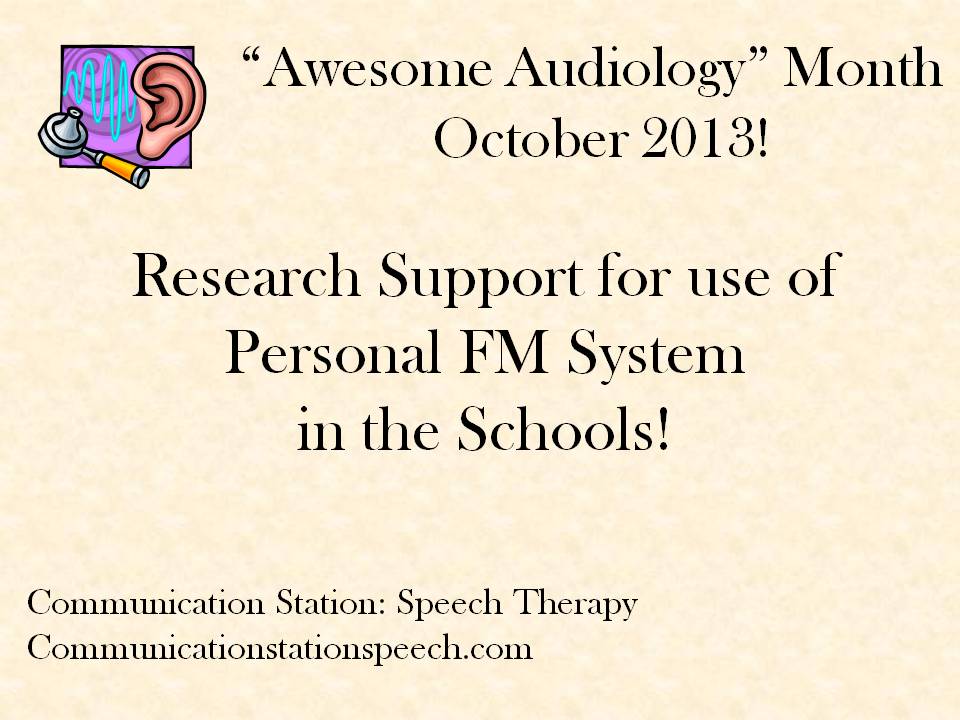Tip Tuesday: Research Supporting use of Personal FM Systems!
This is the third installment of my Awesome Audiology Month! Today we will be talking about research supporting the use of personal FM systems.
If you missed my previous blog and want to read about research support for sound-field systems click here.
A number of studies have been conducted to assess possible advantages to the use of a personal FM system. In 2003, Schafer and Thibodeau, evaluated the use of personal FM systems for sentence recognition in children with Cochlear Implants (CIs) ages 6 to 12 years. Researchers compared the students ability to recognize sentences in both noise and quiet environments. Results indicated a significant improvement in sentence recognition for children with they wore their CIs and used a personal FM system in the noise condition (Schafer & Thibodeau, 2003).
In 2006, Schafer and Thibodeau further assessed the area of speech recognition in noise for children ages 3 to 12 years. This time the participants had bilateral CIs and or CI in bimodal condition (CI + HA (hearing aid) on nonimplant ear) and used a personal FM system on one or both sides. Six out of the total 22 participants where under the age of 5 years. Results indicated that overall speech-in-noise threshold improved up to 20dB when using personal FM system as compared to no FM system use, thus indicating once again significant benefit to use of FM system for speech recognition (Schafer & Thibodeau, 2006).
Speech perception in children 7 to 17 years of age, who used both a CI and personal FM system was assessed in 2001 by Davies, Yellon, and Purdy. Researchers used the HINT (Hearing in Noise Test) for data collection to investigate the degree to which FM systems benefit children with CIs. This test provides lists of sentences presenting in a noise environment. Results indicated a significant benefit for speech perception when a personal FM system is used. In addition, researchers also noted that as children with CIs gained more experience with the use of FM systems, the greater the advantage was observed (Nelson, Poole & Munos, 2013).
Research appears to be demonstrating consistent results regarding the positive effects on speech perception with the use of personal FM systems on children with CIs. However, do personal FM systems also benefit children with HAs? And is there a benefit to using FM systems in the classroom setting? Anderson and Goldstein attempted to address these questions in their 2004 article titled Speech Perception Benefits of FM and Infrared Devices to Children with Hearing Aids in a Typical Classroom. They used the HINT sentence lists to assess eight children ages 9 to 12 years of age. All study participants used binaural HAs and were tested in noise levels consistent to that of a classroom listening environment. Researchers compared the participants speech perception abilities when wearing only HAs, wearing HAs and using a personal FM systems, wearing HAs and using an infrared sound-field system (with 2 wall mounted speakers) and wearing HAs while using a desktop sound field system. Compared to use of HAs alone, results indicated the use of personal FM systems or desktop sound field system in addition to use of HAs improved speech perception scores. However, the use of a classroom sound-field amplification system was not reported to positively affect speech perception skills (Anderson & Goldstein, 2004).
Schafer and Kleineck supported the above results in 2009 when they analyzed 9 different studies to determine the types of hearing assistive technologies that could be beneficial for children with CIs in the classroom setting. Meta-analysis of these studies determined that the use of a desktop sound field system or a personal FM system in conjunction with the use of CIs significantly improved speech recognition performance as compared to the use of CIs alone. Conversely, sound-field systems were not shown to be as effective in noise environments (Schafer & Kleineck, 2009).
The above studies indicate a positive advantage of personal FM systems for children with HAs and CIs in classroom environments. In fact some research go so far as to indicate a more significant advantage with the use of FM systems or desktop sound-field systems as opposed to the use of classroom sound-field systems. This article contains only a few research studies on this subject. I encourage you to use this post as a stepping stone when conducting your own research on this subject.
Resources:
Anderson, K. L., & Goldstein, H. (2004). Speech perception benefits of FM and infrared devices to children with hearing aids in a typical classroom. Language, Speech, and Hearing Services in Schools, 35, 169–184.
Nelson, L., Poole, B., & Munos, K. (2013). Preschool teachers’ perception and use of hearing assistive technology in educational settings. Language, Speech and Hearing Services in Schools, 44, 239-251. doi: 10.1044/0161-1461(2013/12-0038).
Schafer, E. C., & Kleineck, M. P. (2009). Improvements in speech recognition using cochlear implants and three types of FM systems: A meta-analytic approach. Journal of Educational Audiology, 15, 4–14.
Schafer, E. C., & Thibodeau, L. M. (2003). Speech recognition performance of children using cochlear implants and FM systems. Journal of Educational Audiology, 11, 15–26.
Schafer, E. C., & Thibodeau, L. M. (2006). Speech recognition in noise in children with cochlear implants while listening in bilateral, bimodal, and FM-system arrangements. American Journal of Audiology, 15, 114–126.

No comments yet.